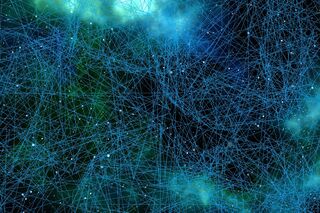Persuasion
You’re Not an Individual, and Here’s Why
Social networks influence you in startling ways.
Posted March 5, 2021 Reviewed by Abigail Fagan
COVID-19 has driven home just how interconnected our world is—a virus that starts in only one place can quickly exploit travel networks and be everywhere. But what does that have to do with who we are and the choices we make?
From Black Panther to GI Jane, from The Lion King to The Matrix, you’ve probably seen the story countless times: A hero is a tough individual. They have a supporting cast of friends, but ultimately, they forge their own path in life. The concept of the individual making choices for themselves is central to the philosophies, institutional structures, and common sense of individualist cultures. But is it true?
The philosopher Theodor Adorno once pointed out that “a human being only becomes human at all by imitating other human beings.” While this is obvious, our focus on the rugged individual can lead us to downplay it.
Even though we all learned how to be ourselves through imitation and some amount of accidental or deliberate innovation (we’re not perfect at copying), we mostly feel like, by the time we’re adults, we’re making our own careful choices.
That’s our inner experience and it seems obviously true. That’s why the findings of network science are so shocking.

Economist Matthew Jackson shares in his book The Human Network: “Taking advantage of various forms of randomization, either by chance or by researchers, there are now many examples where we see people being influenced by the decisions and experiences of those around them, from whether Harvard Business School graduates choose to become entrepreneurs based on classmates’ experiences, to which apps people adopt, to whether people enroll in a retirement plan, to whether people exercise, to which stocks people buy and sell.”
Sociologist Nicholas Christakis explains that studies on obesity, drinking, smoking, altruism, and divorce all show that not only do we cluster together with people who are like us, but that our behaviors can also spread to friends and friends of friends, even helping to change what people we never meet think of as normal.
Sociologist Damon Centola offers various striking examples in his new book Change. One four-year study of more than 800 doctors found that they were giving cancer patients very different treatments. The researchers tried to identify why and realized that it wasn’t because of medical literature advising one treatment over another. It had nothing to do with the illness itself, the size of the medical practice, or even any financial reasons.
It was how many others in the doctor’s social networks were giving out that same treatment! Life and death decisions by experts can be heavily swayed by what feels normal and legitimate simply because of who they’re connected to.
Even some forms of depression, where negative thoughts play a significant role, spread between people. They can hang around in university residences year after year, after the students who originally brought the thought patterns in have graduated. Researchers who studied this said it was “like a lingering flu.”
We’re living in a whole ecosystem of beliefs and norms that shapes us far more than we’re aware of.
This means both that we’re vulnerable to the information and choices playing out in our networks (often among people we’ll never meet), and that we’re more powerful than we imagine, having the ability to influence people we don’t even know. So be careful what you’re spreading.
Who we group with both influences, and is influenced by, our identity. Our tendency to spend our time with people who are like us is called homophily. It’s widespread all over the world.
Matthew Jackson explains, “It is rare to find societies without homophily, and it occurs along many dimensions including gender, ethnicity, religion, age, profession, education level, and can even be seen in genetic markers. It is hard to find a characteristic for which homophily is not present.”
As just one example, he reports on a study of the Hadza in Tanzania that found “significant homophily on many dimensions, including age, height, weight, body fat, and strength, even after controlling for other traits. For instance, an increase of 7.5 kilograms in how similar people are in body weight triples the probability that they are connected to each other.”
The takeaway here is much deeper than, “Wow, the Hadza are sizeist!”

Connecting with people who are similar to us makes sense—if they share the same profession or are at the same stage in life, we can learn from each other, we might have valuable information about an opportunity or how we solved a similar problem. Shared experiences might make it feel easier to form a bond of trust.
There are also irrational reasons for wanting to connect with those who are similar to us, like feeling threatened by those who are different but don’t pose any actual threat.
Whatever the reasons, our preference for people who are like us can obviously contribute to dehumanization, prejudice, and hatred for those who are not like us, to whom we aren’t connected.
Some countries, like Singapore, have tried to reduce homophily through government policies such as quotas for how many people of different ethnicities must live in housing together. This forced integration in turn means that schools are very ethnically diverse and that people grow up regularly interacting with one another, influencing who they trust and feel connected to.
Botswana has gone even further, requiring civil servants to move to new parts of the country when told to by the government. This policy seems to help de-emphasize tribe as an identity divider by creating all sorts of meaningful and sustained intertribal contacts.
In the absence of top-down government policies though, how do networks mobilize to spread new social norms that overcome hate and division?
Studies of who took part in the activism that toppled the Berlin Wall, and in the U.S. civil rights movement—two movements in very different contexts and cultures—found that the answer was the same. It wasn’t people who were more outraged, who had more serious grievances, or more ambition. It was those who had a significant percentage of their social networks taking part too.
This is explained by Centola who writes, “Any change that involves real risk—financial, psychological, or reputational—requires more than simply coming into contact with a single random adopter or ‘carrier.’” That’s because we still see many other non-adopters.
We coordinate our lives with others around us, and being ostracized by our group can lead to social pain that is just as serious and real as the pain from a physical injury. So it’s no surprise that we like to stick to the safety and protection of our social groups. We notice and mostly adhere to the social norms around us.
The bulk of those taking part in the two different social change movements were folks who looked around and saw that a safe percentage of those in their networks were participating, making them feel good about doing it too (maybe even afraid of being conspicuous if they didn’t participate).
Centola explains that research in many different settings has confirmed this finding: “We are typically influenced by the percentage of the people we know who are doing something, rather than the total number.”
So new norms spread first by developing a critical mass of supporters who are connected with each other (because then a high percentage of those they know are also following that new norm). Once this base exists, it can expand. Centola describes this exact process happening in the spread of the movement that toppled the Mubarak regime in Egypt and in the movement for Black lives in the U.S.




